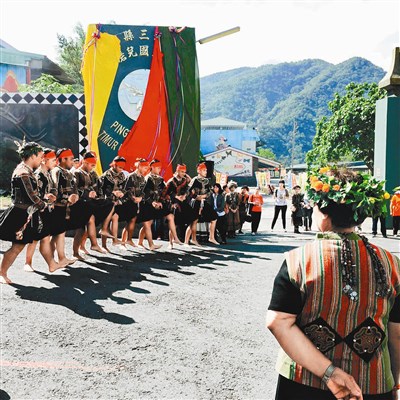 部落青年為慶祝地磨兒國小百年。
(地磨兒青年移動學校提供) 圖/林格立
部落青年為慶祝地磨兒國小百年。
(地磨兒青年移動學校提供) 圖/林格立
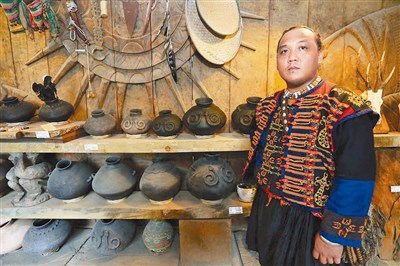 排灣族藝術家拉夫拉斯.馬帝靈將傳統文化融為藝術創作。(地磨兒青年移動學校提供) 圖/林格立
排灣族藝術家拉夫拉斯.馬帝靈將傳統文化融為藝術創作。(地磨兒青年移動學校提供) 圖/林格立
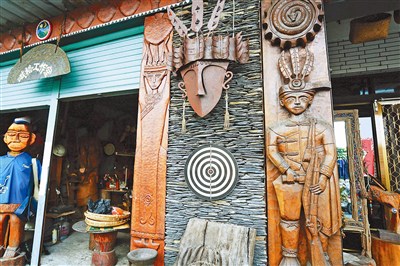 走進屏東三地門鄉地磨兒部落,沿途可見木雕、石板屋……,處處充滿原民傳統風情。(地磨兒青年移動學校提供) 圖/林格立
走進屏東三地門鄉地磨兒部落,沿途可見木雕、石板屋……,處處充滿原民傳統風情。(地磨兒青年移動學校提供) 圖/林格立
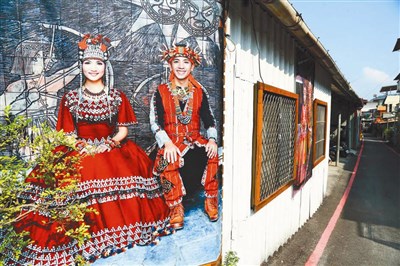 走進屏東三地門鄉地磨兒部落,沿途可見木雕、石板屋……,處處充滿原民傳統風情。�(地磨兒青年移動學校提供) 圖/林格立
走進屏東三地門鄉地磨兒部落,沿途可見木雕、石板屋……,處處充滿原民傳統風情。�(地磨兒青年移動學校提供) 圖/林格立
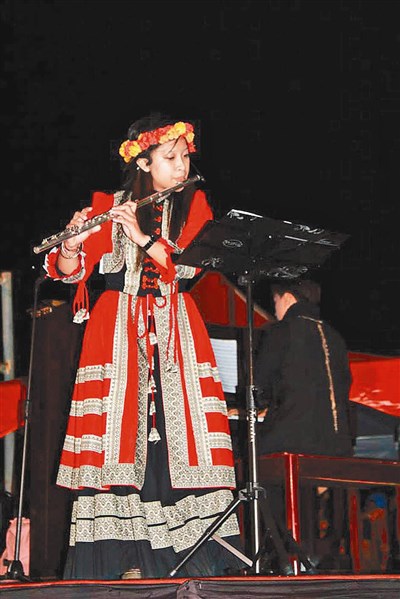 今年年初地磨兒青年移動學校成員舉辦「我在家,輕輕為你唱」音樂會,現場響起傳統古謠、古典音樂等不同樂曲,拉近老中青三代彼此的距離。
�(地磨兒青年移動學校提供) 圖/林格立
今年年初地磨兒青年移動學校成員舉辦「我在家,輕輕為你唱」音樂會,現場響起傳統古謠、古典音樂等不同樂曲,拉近老中青三代彼此的距離。
�(地磨兒青年移動學校提供) 圖/林格立
提要
地磨兒(Timur)是屏東三地門鄉最大的部落,日據時代日人將鄰近排灣族、魯凱族部落遷移集中管理後,形成了今日的聚落面貌。
走進部落裡,產業道路旁一身排灣族傳統服飾的人物插畫、居民活動鄉公所的仿石板屋風格,處處充滿了原民風情。除了外界熟悉的文化符碼,近年來地磨兒部落更在一群新世代原住民的號召下,以部落為師、向耆老學習,喚回日漸遺失的傳統文化。
Timur, located in northern Pingtung County, is the largest Aboriginal community in Sandmen Township. During the Japanese Occupation Era (1895–1945), the Japanese forced neighboring Paiwan and Rukai groups to live in one place, to make it easier for the authorities to control them, thereby forming the Timur that exists today.
Everywhere in Timur there are stylistic elements characteristic of indigenous cultures. Along one side of the forestry road are wall paintings depicting Aboriginal people in traditional Paiwan attire, while the town hall is built in an imitation stone slab design. But beyond these tangible cultural symbols that even outsiders are familiar with, in recent years a group of young people in Timur have taken the initiative to learn from their elders as they attempt to preserve their rapidly disappearing traditional customs.
In April of 2015, on the occasion of the 100th anniversary of the founding of the Sandi Primary School in Sandimen Township, Pingtung County, the school was renamed "Timur", the Paiwan name of the village. This is a very important symbol of efforts to preserve and pass along traditional culture. Even earlier, in August of 2014, a group of young people in the community, recognizing that their traditional culture was being lost, decided to launch the "Timur Youth Mobile School" (TYMS)to record the memories and customs that had once been common knowledge among the indigenous residents.
Lavuras Matilin, a 28-year-old Paiwan artist, is one of the founders of TYMS. Eleven years ago he returned to Timur to take care of his ailing mother, and discovered that young people—as a result of going to school away from home or relocating outside the community—were steadily becoming estranged from tribal traditions, while old people were passing away one after another, meaning that knowledge of traditional culture was rapidly disappearing. He got the idea for the "mobile school" two or three years ago, and when he finally brought it up with his friends, he got a very enthusiastic response. Thus TYMS took form.
After TYMS was launched in August of 2014, scattered tribal young people connected through Facebook, and in the short period of a year or so, held more than ten activities.
As for "classes", which are organized on an ad-hoc basis, TYMS brings small children from the indigenous community to the home of a "Vuvu" ("elder" in the Paiwan language) to hear them talk about tribal traditions. The kids may also end up learning from these elders things like weaving, traditional songs or chants, or the origin stories of the tribal name.
"There are things to be gleaned from the stories the elders tell, from the places where they work…... everything,"says Lavuras. The concept underlying the founding of TYMS is that the passing on and learning of traditions should be free-form, without restrictions, so that "the whole indigenous community is itself a school."
Although Lavuras thinks of TYMS as an experiment, and no one knows whether it will succeed or fail as time goes on, in any case "the community has definitely become different," he says.
A concert held in January of this year, entitled "At My Home, I Will Gently Sing For You," was especially encouraging to TYMS members.
Ljuzem Tjaljialep, 29, who is currently a graduate student of ethnomusicology at Tainan National University of the Arts, was the moving force behind the concert. Having attended schools away from home since she was small, Ljuzem, who frequently travels back and forth between the city and Timur, continually thought about how she could take what she learned at school and do something positive for her community. After joining TYMS last year, she proposed the idea of a concert to Lavuras. To her surprise he readily assented, and the concert for their hometown quickly took shape.
The concert held in early January of 2015 is still a cherished memory for many, but for Ljuzem it was an unforgettable performance. Given her background as a music major in university, she has never lacked for performance opportunities, so being on stage is quite routine for her. But for the Timur concert, she had a special reason to be nervous: "After so many years away, to have this concert before the people of my hometown, I was very worried: Would the members of the tribe accept me as one of their own?"
Returning to the community was just the first step for Ljuzem in her search for her real self. In the future she has an even larger objective. Recently, young indigenous people from all over Taiwan have actively participated in bringing tribal cultures to the international stage. And prior to this, the Lima Taiwan Indigenous Youth Working Group had attended the United Nations Permanent Forum on Indigenous Issues. Ljuzem has similar dreams.
Although she has been back home for less than three years, Ljuzem Tjaljialep already realizes that long-fading tribal traditions cannot be revitalized in a short time. But in the future she hopes to take the music of her hometown to the ICTM, which devotes special attention to the music of minority peoples around the world. "I want to bring out our own style to be seen by everybody."
For Lavuras, himself an artist, the creative "nutrients" that he carries around with him like a genetic inheritance come from the community. "If these nutrients disappear, then we are nothing," he says.
The installation work Kala Are you OK? that Lavuras exhibited in 2014 at the Songshan Cultural and Creative Park in Taipei is a work inspired by something that Lavuras saw repeatedly during community recreational events: karaoke. He explains that the theme of the work is "communication." Because people are not especially good at communicating, they have to rely on other means to give vent to their feelings and express the things they want to say, and karaoke is one such means.
As Lavuras concludes: "Despite the fact that this piece has no typical Aboriginal cultural symbols, the soul of the work derives from the community." As the young people of Timur and other indigenous communities strive to maintain an identity of their own, whatever outward forms this identity may take, it is this "soul" to which they must remain firmly anchored.
翻譯
今年四月,位於屏東三地門鄉三地國小在屆滿百年之際,改以排灣族名「地磨兒」命名,為傳統的延續標誌了重要意義。而早在二○一四年八月,一群部落青年有感於傳統文化喪失,決定自發成立「地磨兒青年移動學校」,留下傳誦部落許久的記憶與文化。
今年二十八歲的排灣族藝術家拉夫拉斯.馬帝靈,是移動學校的發起人之一。他表示,每年夏天的收穫祭是部落的年度大事,在外工作、求學的青年遊子,都會回到家鄉參與這場盛會。但活動一結束,好不容易凝聚起的情感,又將隨著各自返回崗位而消逝。
拉夫拉斯十七歲時,為了照顧生病的母親而返鄉,發現部落年輕人因為在外求學、生活,對於傳統漸漸陌生,加上耆老衰老辭世,原住民的傳統文化正快速流失。二、三年前,就有打造移動學校想法的拉夫拉斯趁機向朋友說起,立刻獲得大家熱烈響應,「地磨兒青年移動學校」就此成形。
二○一四年八月「地磨兒青年移動學校」開辦,四散各地的成員靠著臉書聯繫,在短短一年多的時間內就舉辦了十多場活動。
在不定期舉辦的課程裡,TYMS帶著部落小朋友來到Vuvu(排灣族語長輩)家中,聽他們講述部落傳統,也跟著耆老學習編織、吟唱古謠、認識族名的起源。
日前一群青少年由村莊出發徒步走回舊達來部落,在山林學習打獵,感受昔日的生活。而在排灣族象徵勇士榮耀戰功的「勇士舞」,也在移動學校的推動下,成為部落青年認識傳統的一項重要活動。
「耆老說的故事、工作的地方,都有值得學習之處。」拉夫拉斯表示,TYMS成立的概念,就是要傳遞學習是自由的、沒有拘束的,「部落就是學校。」
儘管拉夫拉斯認為「地磨兒青年移動學校」像是一場實驗,未來的成敗與否仍不得而知,但部落「真的變得不一樣了。」他說。
今年一月初舉辦的「我在家,輕輕為你唱」音樂會,更鼓舞了青年移動學校的成員。
二十九歲,現為台南藝術大學民族音樂系研究生的陳琦婷,是活動發起人。從小在外求學的陳琦婷,大學回到部落教學後,心裡始終惦記著哪天能將所學回饋家鄉。去年加入TYMS不久後,她向拉夫拉斯提起籌辦音樂會的構想。沒想到在拉夫拉斯一句輕描淡寫的允諾下,一場為家鄉而辦的音樂會很快就誕生了。
二○一五年一月初舉辦的音樂會,至今讓許多人回味再三,對陳琦婷而言更是一場難忘的演出。有音樂系背景的陳琦婷,不乏演出機會,上台表演像是家常便飯,但這場演出最讓她緊張的是,「自己長年在外生活,很擔心這場回到家鄉的演出會不會被族人認同。」
回到部落只是陳琦婷找回自己的第一步,未來她還有一個目標等待實現。近來,全台灣新世代的原住民青年積極帶著部落文化站上國際舞台。此前,Lima台灣原住民青年團就曾參與聯合國原住民議題常設論壇。陳琦婷也有這樣的夢想。
回家不過三年時間的陳琦婷發現,空白許久的部落文化,無法在短時間內一下補足,但未來她希望能帶著家鄉音樂參與國際關注少數族群傳統音樂的ICTM,「用我們的方式,被大家看見。」
對於本身就是藝術家的拉夫拉斯,創作的母體養分來自部落,「如果養分消失了,我們什麼都不是。」他說。
二○一四年在松山文創園區展出的裝置藝術「卡拉當下你還好嗎?」則是拉夫拉斯以常常出現在部落娛樂活動的卡拉OK發想的創作。拉夫拉斯表示,這件作品想表達的是「溝通」。人們因為不善溝通,只好透過各種方式宣洩,表達想要說的事情,而卡拉OK就是其中一種。
「儘管作品沒有原住民的文化符碼,但我的創作靈魂卻是來自部落。」拉夫拉斯說。
(摘錄轉載自104年9月《台灣光華雜誌》
全文請參考http://www.taiwan-
panorama.com/)
WOW!原來如此
estranged
「estranged」是「疏離、久未聯絡的」,例如:
Anika said she had encountered her long-estranged father. ( 阿妮卡說她碰到了闊別多年的父親。)
The old man was laid to rest last month without a final goodbye from his estranged daughter.(那老人上個月去世了,久未聯絡的女兒沒來作最後的道別。)
independent filmmaking became increasingly estranged from the mainstream of Hollywood. (美國獨立製片變得愈來愈脫離好萊塢的主流風格。)
launched
「launched」意思是「發射、發動;展開」,例如:
A rocket was launched from Cape Canaveral early this morning. (一枚火箭今早在美國佛州卡納維拉爾角發射升空。)
The ferry capsized with such alarming speed, there was no time to launch the lifeboats. (那艘渡輪瞬間翻覆,完全沒時間放下救生艇。)
The police have launched an investigation into the incident. (警方已對該事件展開調查。)
scattered
「scattered」是「零散、到處都是的」,例如:
He picked up the scattered toys in his daughter’s room.(他把女兒房間到處都是的玩具收拾好。)
Scattered groans and whoops broke out in the crowd.(人群裡此起彼落地發出抱怨和歡呼聲。)
There will be a few scattered showers tomorrow.(明天局部地區將會有陣雨。)